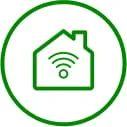For decades, rural communities across America have faced a persistent challenge: Limited access to high-speed internet that could unlock their economic potential. Groundbreaking new research is proving what many have long suspected—that fiber internet isn't just a utility, it's an economic engine that can transform entire regions.
A comprehensive study released in 2024 by the Center on Rural Innovation (CORI) provides compelling evidence that fiber-connected rural communities experience dramatically higher rates of business growth, entrepreneurship and income increase compared to their underserved counterparts. The findings underscore a critical truth: when rural America gets connected with high-quality fiber internet, prosperity follows.
The numbers don't lie - fiber internet drives measurable economic impact
The CORI study, titled "Beyond Connectivity: The Role of Broadband in Rural Economic Growth and Resilience," analyzed economic data from three distinct types of rural communities: those that remain underserved, communities with access to basic internet services and communities served by robust fiber internet networks with high adoption rates.
The results are striking. Rural communities with high-quality fiber internet and adoption rates above 80% experienced:
- 213% higher business growth compared to underserved areas
- 10% higher self-employment growth, fostering local entrepreneurship
- 44% higher GDP growth, strengthening the overall economic foundation
- 18% higher per capita income growth, translating to nearly $1,000 more per person annually from 2020-2022
These aren't just statistics—they represent real families starting businesses from their kitchen tables, local entrepreneurs launching innovative services and communities building sustainable economic foundations for the future. The study emphasizes that it's not enough to simply have fiber internet available; communities need both high-speed fiber infrastructure and widespread adoption to realize these transformative benefits.
Bridging the digital divide, building economic bridges
Fast, reliable fiber internet access addresses long-standing inequities that have held rural communities back for generations. When residents can access the same digital opportunities as their urban counterparts, the ripple effects extend far beyond individual households.
In education, students gain access to online learning resources, virtual tutoring and college preparation tools that were previously out of reach. Healthcare becomes more accessible through telemedicine consultations, allowing residents to consult with specialists without long drives to urban centers. Employment opportunities expand dramatically as remote work becomes viable, enabling rural residents to compete for jobs anywhere in the country while remaining rooted in their communities.
Perhaps most importantly, quality fiber internet infrastructure creates the foundation for local economic development. Small businesses can reach global markets, agricultural operations can leverage precision farming technologies and communities can attract new residents and businesses looking for affordable locations with urban-level connectivity.
Case study in action: Ziply Fiber's Highway 530 corridor project
While research demonstrates the potential of fiber internet, Ziply Fiber is putting these principles into practice through real-world infrastructure investments. Our Highway 530 Corridor Project best exemplifies how strategic partnerships and committed investment can transform rural connectivity.
Working in partnership with Snohomish County and the Washington State Broadband Office, this $27.6 million initiative represents one of the most significant fiber internet expansions in the Pacific Northwest. The project received a $16.7 million grant from the state, with Ziply Fiber covering the remaining costs to ensure completion.
The scope of this undertaking is impressive: We're constructing a fiber-to-the-premises network spanning from Arlington to Darrington along the SR-530 corridor. When complete, this infrastructure will connect approximately 5,600 locations—including over 4,000 households that previously struggled with limited connectivity options.
But this project goes beyond residential connections. We're prioritizing "Community Anchor Institutions"—the essential services that form the backbone of rural communities. This includes:
- Enhanced telehealth access through improved connections to medical facilities
- Remote work enablement for thousands of households, allowing residents to access employment opportunities while staying in their communities
- Better emergency response capabilities with reliable connectivity for fire stations and emergency services
- Strengthened digital resources at libraries and community centers, providing access points for residents and supporting digital literacy programs
The project timeline demonstrates our commitment to rapid deployment, with construction underway and expected completion in 2025.
Strengthening the foundation: infrastructure for long-term success
The Highway 530 project illustrates how fiber internet strengthens the entire ecosystem of rural community infrastructure. When emergency responders have reliable communication tools, they can coordinate more effectively during crises and provide better service to residents. When libraries and community centers offer high-speed fiber internet access, they become hubs for digital inclusion and economic opportunity.
This infrastructure also supports the kind of value-added services that the CORI research identifies as crucial for economic impact. With robust fiber internet connections, communities can support advanced applications like precision agriculture, telemedicine platforms and e-commerce solutions that drive business growth and employment.
The sustainability of this approach is particularly important. Unlike temporary economic development programs, fiber internet infrastructure creates lasting value that compounds over time. As more residents and businesses gain access to high-speed fiber internet, network effects multiply the benefits throughout the community.
Building toward a connected future
The combination of rigorous research and practical implementation tells a clear story: Fiber internet is not a luxury for rural communities—it's an essential economic development tool. The CORI study provides the evidence, and projects like our Highway 530 Corridor initiative demonstrate the commitment needed to turn that evidence into reality.
At Ziply Fiber, we're not just building networks; we're building pathways to economic opportunity. Our ongoing investments in rural infrastructure reflect our understanding that America's economic future depends on ensuring all communities—regardless of geography—have access to the digital tools they need to thrive.
As we continue expanding our network across the Northwest, we remain committed to the partnerships required for rural fiber internet success. The economic benefits documented by researchers are already beginning to materialize in the communities we serve, and we're excited to support even more rural areas in unlocking their economic potential.
The digital divide doesn't have to be permanent. With continued investment, strategic partnerships and proven technology, we can ensure that rural America's next chapter is defined not by isolation, but by connection—to each other, to opportunity and to a more prosperous future.






